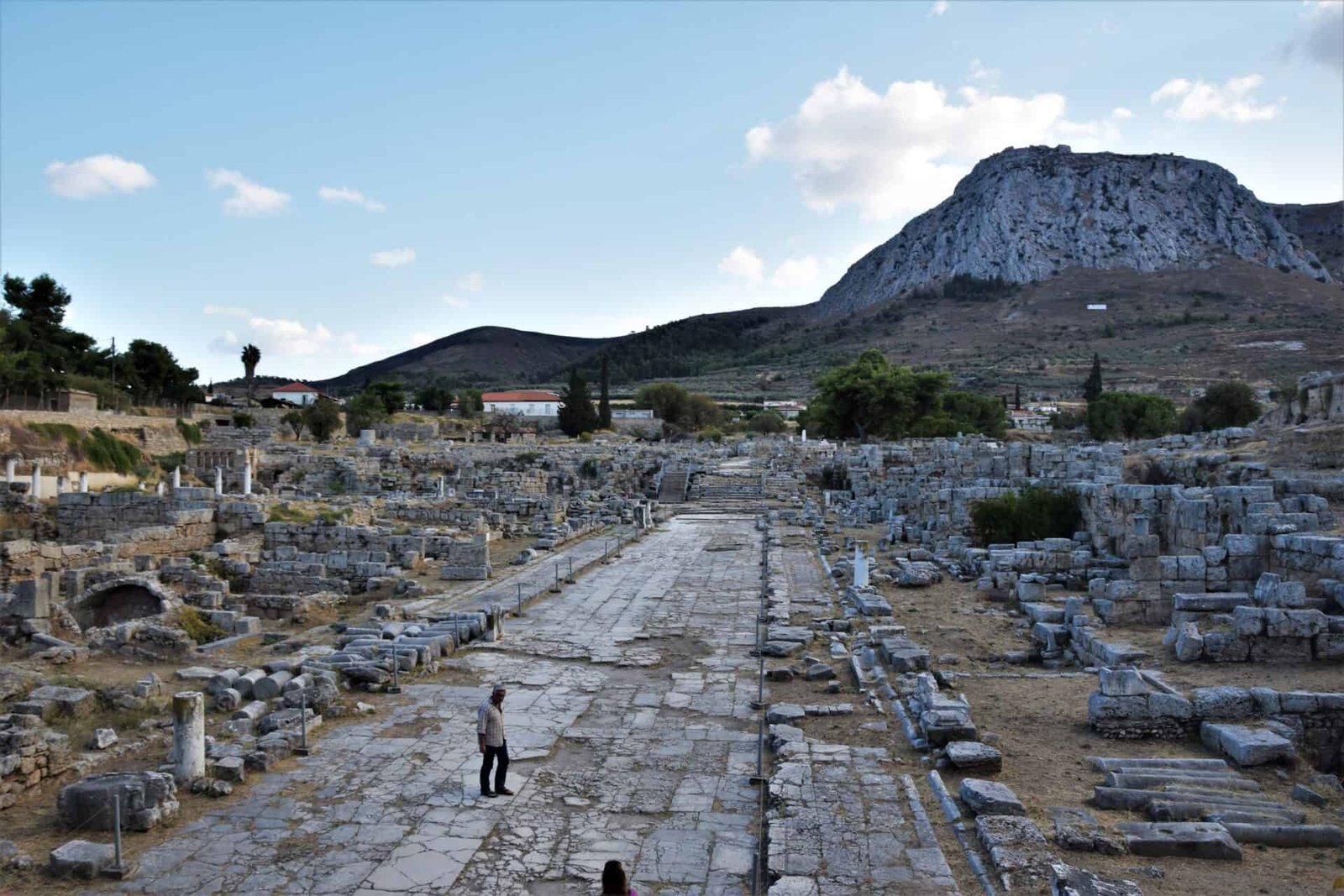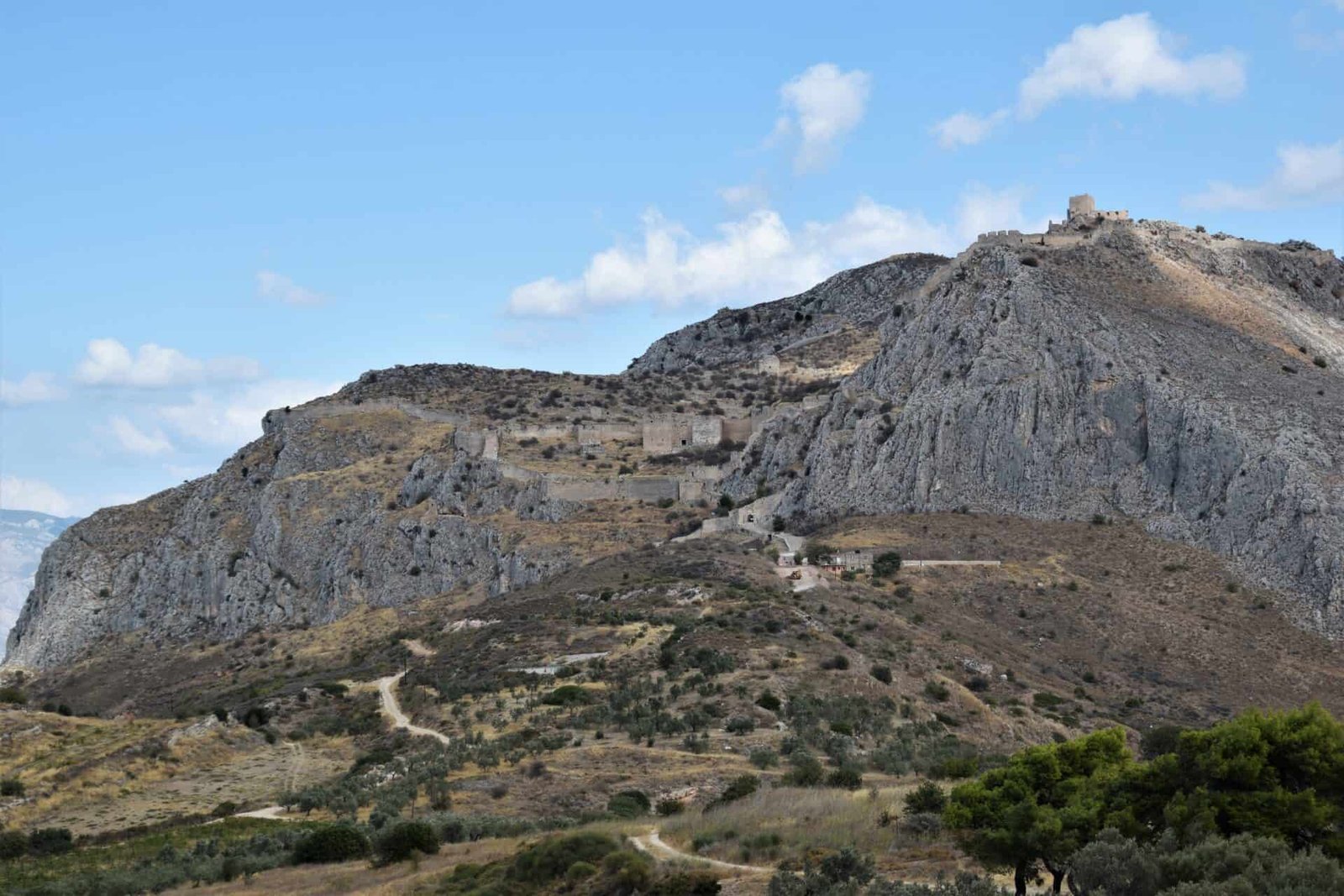Just beyond the gaping fissure surgically cut through the narrow isthmus between the Peloponnese and Attica, rest the remnants of one of Ancient Greece’s most prolific cities: Ancient Corinth. Once the undisputed guardian of the peninsula, her impressive ruins now lie scattered among the parched grass.
According to legend, the city was first founded by Corinthos, a son of Zeus, however, it remains uncertain when Corinth’s ascent as a prosperous polis truly began.
In the 8th century BCE, the city entered her golden age, an era of immense economic and cultural prosperity closely linked to the political hegemony of the Bacchiadae family and the foundation of colonies in both Corcyra and Syracuse, firmly establishing Corinth as one of the wealthiest poleis at the time. However, following her costly participation in the Persian Wars, emerging inner-Greek feuds, and a growing commercial conflict with a rising Athens heralded the slow decline of this once powerful city state.
In 146 BCE, it was the Romans who dealt the final blow. The legions of the Republic were merciless. Corinth was razed to the ground, her riches plundered, and her citizens slaughtered or sold into slavery. Even though, Caesar successfully re-established the city as the provincial capital a century later, she never fully recovered.
Today, the archaeological parks of both the ancient city proper and the magnificent acropolis Acrocorinth stand testament to Corinth’s former might.


ANCIENT CORINTH
Although, much of the former polis has been lost to the ages or been built over, the excavated remains inside the archaeological park hint at the immense wealth that once presided along the Peloponnese’s northeastern shores.
Dominating the unearthed ensemble, the enormous seven columns of the temple of Apollo thereby form the centre piece of the ancient city. Surrounded by further ruins of shrines, public buildings, market arcades, the steps of a theatre, fountains, and the remnants of the agora, Corinth’s cultural and mercantile significance is palpable.
During your visit, you will also be invited to explore the beautiful hallways and open atriums of the Archaeological Museum of Corinth, showcasing the rich Roman and Greek artifacts discovered over the years, including delicate pottery, elaborate murals and mosaics, as well as an extensive collection of marble statues.
Though relatively compact, calculate 1-2 hours, especially if you wanna take your time in the museum.
Entrance fee | General admission: 8€ | Reduced: 4€
Free Admission | 6 March | 18 April | 18 May | 5 June | 28 October | last weekend of September | 1st Sunday of each month from 1 Nov-31 Mar
Opening Hours | Winter 10.12-10.4 8:00-15:30 | 11.4-31.8 8:00-20:00 | 1.9-15.9 8:00-19:30 | 16.9-30.9 8:00-19:00 | 1.10-15.10 8:00-18:30 | 16.10 – 31.10 8:00- 18:00 | 1.11-9.12 8:00-17:00
Closed | 1 January | 25 March | 1 May | 25/26 December | Orthodox Easter Sunday | on Tuesdays (only during winter)
How to get there | Buses run daily from Corinth’s main bus station (across the street from the old train station) to the archaeological park.


ACROCORINTH
Towering high above the isthmus, Acrocorinth has always been the city’s main attraction. Besides her cultural importance as the religious and courtly centre of Ancient Corinth, over the millennia, dominion over the acropolis was fiercly contested, as her strategic location at a crossroad of both maritime and terrestrial trade routes promised prestige, wealth, and political leverage in abundance.
Although, the blue and white flag of the Hellenic Republic now flys proudly from the battlements, it represents but a short chapter of the citadel’s eventful history that has seen many a people plant their banners atop her imposing walls.
Step through her gates to find an eclectic mix of Byzantine churches, Turkish mosques, Frankish fortifications, and Venetian bastions granting a fleeting glimpse into a time when Acrocorinth truly was the guardian of the Peloponnese.
Also, be aware that Acrocorinth is vast. I spent roughly 3 hours exploring the different parts of the acropolis and felt a bit rushed at times, so schedule ample time. Below you will find a short list of points of interest to guide you through your next visit to Acrocorinth.
The Temple of Aphrodite
Devoted to Aphrodite, the city’s guardian and goddess of love, beauty, and pleasure, this temple once formed the centre piece of cult in Corinth. Said to have housed hundreds of courtesans dedicated to the worship of the most sensual of deities, tales of temple prostitution travelled far and attracted pilgrims from all corners of the Hellenic world. Although, these erotic accounts of divine debauchery have since been questioned by scholars, the importance of the sanctuary to the people of Corinth is undeniable.
Unfortunately, this temple of ethereal lust has not survived the ages, and the only foundations visible today stem from Byzantine times. The spot offers sweeping views of the Isthmus of Corinth, though, hence an ascent is definitely recommended!
The Upper Peirene Spring
Hidden away at the far end of Acrocorinth lies the mythical Upper Peirene Spring.
According to the Greek traveler Pausanias, the spring was a gift by the river god Asopus to Sisyphus, fabled king of Corinth, who had previously witnessed the ravishment of Asopus’ daugther Aegina by Zeus and now demanded the spring as compensation to reveal this most unsettling truth. As punishment for unmasking the Greek Allfather, Sisyphus was sent to Hades but successfully escaped his fate for a first time.
The spring was also visited by the legandary hero Bellerophon. Tasked to slay the abominable Chimaera, a hellish, fire-breathing beast terrorising the distant swaths of Lycia, the warrior was warned that he would be in need of the winged steed Pegasus to succeed in this dangerous endeavour. Aided by the goddess Athena and the Corinthian seer Polyeidos, Bellerophon managed to capture the unsuspecting creature while it drank from the well, and hence went forth to vanquish the vile monster.
The cistern can be entered via a narrow staircase and is rumoured to never dry up.



The Frankish Tower
Except for the three colossal gates shielding Acrocorinth’s western flank, the Frankish Tower is the most prominent structure of the complex.
The exact date of its constructen has been lost but is assumed to have happened somewhen between the 13th and 14th century, following the disastrous failure of the 4th crusade and the ensuing Frankish occupation of Greece.
You can also climb to the top of the tower to enjoy stunning vistas over the Peloponnese.
Montesquieue Castle/Penteskouphi
Easily missed, the ruins of another, albeit infinitely smaller, castle grace the top of a pyramid-shaped outcrop opposite the citadel’s main entrance. Erected during the Frankish siege of Acrocorinth at the beginning of the 13th century, few but the crumbling foundations remain.
While the castle itself is not worth the detour, the hill offers sensational views of Acrocorinth and the rock it sojourns on.
Entrance fee | free
Opening Hours | 8:00-15:30 (probably longer hours in summer comparable to those of the ancient city)
Closed | 1 January | 25 March | 1 May | 25/26 December | Orthodox Easter Sunday | on Tuesdays
How to get there | Since there are no buses going directly to the citadel of Acrocorinth, you can either opt for private transport or take the bus to the archaeological park of Ancient Corinth and hike up to the acropolis. Buses to the ancient city run daily from Corinth’s main bus station (across the street from the old train station).
Should you chose to walk, simply follow the brown signs pointing you in the direction of the ancient site. It will roughly take an hour (3,5km) to reach the main entrance on foot.
The bus returning to Corinth will leave from the same spot the driver will have dropped you off earlier (near the entrance to the archaeological park of Ancient Corinth). During low season buses are very infrequent so make sure to check the schedule beforehand.
